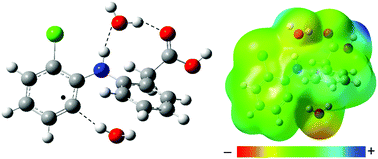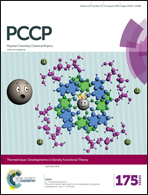Computational insights into the photocyclization of diclofenac in solution: effects of halogen and hydrogen bonding†
Abstract
The effects of noncovalent interactions, namely halogen and hydrogen bonding, on the photochemical conversion of the photosensitizing drug diclofenac (DCF) in solution were investigated computationally. Both explicit and implicit solvent effects were qualitatively and quantitatively assessed employing the DFT/6-31+G(d) and SQM(PM7) levels of theory. Full geometry optimizations were performed in solution for the reactant DCF, hypothesized radical-based intermediates, and the main product at both levels of theories. Notably, in good agreement with previous experimental results concerning the intermolecular halogen bonding of DCF, the SQM(PM7) method revealed different values for d(Cl⋯O, Å) and ∠(C–Cl⋯O, °) for the two chlorine-substituents of DCF, with values of 2.63 Å/162° and 3.13 Å/142° for the trans and cis orientations, respectively. Employing the DFT/6-31+G(d) method with implicit solvent effects was not conclusive; however, explicit solvent effects confirmed the key contribution of hydrogen and halogen bonding in stabilizing/destabilizing the reactant and hypothesized intermediates. Interestingly, the obtained results revealed that a protic solvent such as water can increase the rate of photocyclization of DCF not only through hydrogen bonding effects, but also through halogen bonding. Furthermore, the atomic charges of atoms majorly involved in the photocyclization of DCF were calculated using different methods, namely Mulliken, Hirshfeld, and natural bond orbital (NBO). The obtained results revealed that in all cases there is a notable nonequivalency in the noncovalent intermolecular interactions of the two chlorine substituents of DCF and the radical intermediates with the solvent, which in turn may account for the discrepancy of their reactivity in different media. These computational results provide insight into the importance of halogen and hydrogen bonding throughout the progression of the photochemical conversion of DCF in solution.


 Please wait while we load your content...
Please wait while we load your content...